Inward Innovation
 Friday, April 10, 2009 at 11:20PM
Friday, April 10, 2009 at 11:20PM I didn't play Skate It Wii for very long. From the beginning, I was only interested in testing out the Balance Board controls. I've played Tony Hawk for consoles and for the GBA, and I wanted to compare how the Wii controls might change the core skating experience.
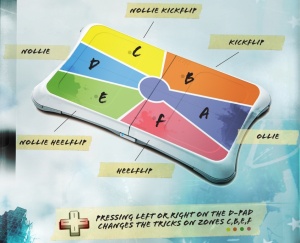 The game itself has less than polished graphics as well as a pretty conventional approach to sound complete with licensed music and voice acting. I found what little I played of the career mode to be a bit unfocused and confusing. I would have much preferred the Wii Sports approach with clear training exercises and a competition mode with a simple difficulty progression.
The game itself has less than polished graphics as well as a pretty conventional approach to sound complete with licensed music and voice acting. I found what little I played of the career mode to be a bit unfocused and confusing. I would have much preferred the Wii Sports approach with clear training exercises and a competition mode with a simple difficulty progression.
The Balance Board controls need some more work. Skate It, being a sort of spiritual successor to the popular Skate game, features an array of complex moves and maneuvers. Compared to the snow boarding game from Wii Fit, the developers had a much more challenging design task ahead of them. Still, the inconsistency and choppy controls of Skate It left much to be desired.
Despite the control short comings, I found skating on a Balance Board to be far more interesting, engaging, and more intuitive than playing with traditional controls. For basic steering, the player must shift their weight across the Balance Board. I found this basic level of interaction must more demanding and engaging than with traditional controls. With an analog stick, the player can easily balance out and steer straight by either letting go of the stick, or holding straight up. But when you're whole body is the functional analog stick, balancing on the middle of the board or leaning/balancing straight forward is a challenge in and of itself.
My experience and impressions of Skate It bring us to the point of this article. The wave of the future for video game design is inward innovation. Instead of creating more modes and options on top of existing video game conventions (more weapons, larger levels, internet play, co-op, larger multiplayer battles, etc) inward innovation looks at existing conventions and redesigns them for the purpose of making them more intuitive, direct, dynamic, analog, organic, and/or engaging. Skate redesigned the Tony Hawk style controls giving the player more direct control over their skater's individual limbs and moves. Skake It redesigned the controls once again turning the player into a virtual skater on a real Balance Board. It's a positive trend, at least in design theory/potential.
Of course, the Skate series is not alone with examples of inward innovation. The following are other examples. Keep in mind that these examples don't necessarily mean that these games were the first to innovate in such a way.
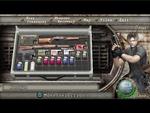 ITEM GRID: RE4 redesigned the basic item inventory so that players have to arrange their guns and items in a grid based case. This little touch puts a greater emphasis on using large items and combining items because large items take up quite a lot of space, and combining items saves a bit of space.
ITEM GRID: RE4 redesigned the basic item inventory so that players have to arrange their guns and items in a grid based case. This little touch puts a greater emphasis on using large items and combining items because large items take up quite a lot of space, and combining items saves a bit of space.
- ITEM ORGANIZATION: Pokemon Red and Blue had a terrible item storage system. Basically, there was one folder for everything and no means of filtering the content. Since then, the latest Pokemon games have refined the item storage system. Items are automatically organized into pockets that are clearly labeled by type (TM/HM, Pokeballs, etc.)
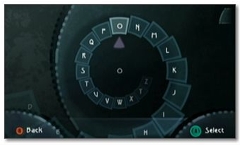 TEXT INPUT: Banjo-Kazooie features an in game text input sytem where players have to beak smash each letter to spell out long codes: "Give that bear lots of air." Keeping the text input system in game may make for a longer, less accurate text inputting experience, but at the same time it's definitely more engaging than just using a menu. The spinning wheel text input in Beyond Good & Evil is one of the greatest controller based text input systems I've ever seen. This circular system is much more direct for an analog stick. Instead of restricting navigation to four directions like with a D pad, the wheel text allows players to circle around with the analog stick to reach the letter they need. Spinning the stick is very smooth and very quick compared to other systems.
TEXT INPUT: Banjo-Kazooie features an in game text input sytem where players have to beak smash each letter to spell out long codes: "Give that bear lots of air." Keeping the text input system in game may make for a longer, less accurate text inputting experience, but at the same time it's definitely more engaging than just using a menu. The spinning wheel text input in Beyond Good & Evil is one of the greatest controller based text input systems I've ever seen. This circular system is much more direct for an analog stick. Instead of restricting navigation to four directions like with a D pad, the wheel text allows players to circle around with the analog stick to reach the letter they need. Spinning the stick is very smooth and very quick compared to other systems.
- Wii CONTROL CORE MECHANICS: With Wii Sports, Wii Fit, Boom Blox, Excite Truck, and Skate it, the core mechanics were redesigned to implement motion/balance/pointer controls to make all the game interactions more intuitive, analog, direct, and engaging.
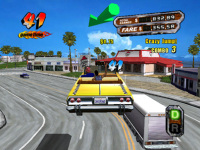 DYNAMIC DIRECTIONS: Crazy Taxi was one of the first games to use a dynamic directions system. The arrow at the top of the screen not only pointed in the direction of a passenger's destination, but it even adjusted to give turn by turn directions. Now, games like the new Prince of Persia have taken dynamic directions to the next level. Hit the COMPASS button and a ball of light will shoot out and bounce around the environment illuminating the path that the player should take. This is a much more organic solution. Dead Space organically integrated its direction system as well. The cell phone in GTA4 provides GPS like directions as well as a way to join multiplayer matches, call in game characters, and access the game menu.
DYNAMIC DIRECTIONS: Crazy Taxi was one of the first games to use a dynamic directions system. The arrow at the top of the screen not only pointed in the direction of a passenger's destination, but it even adjusted to give turn by turn directions. Now, games like the new Prince of Persia have taken dynamic directions to the next level. Hit the COMPASS button and a ball of light will shoot out and bounce around the environment illuminating the path that the player should take. This is a much more organic solution. Dead Space organically integrated its direction system as well. The cell phone in GTA4 provides GPS like directions as well as a way to join multiplayer matches, call in game characters, and access the game menu.
- INTEGRATED/REDUCED HUD: Condemned, Dead Space, and Team Fortress 2 each have addressed how to minimize their in game HUD with organic solutions. Condemned uses an "inside my jacket" item menu. Dead Space projects the data on and around the player character using futuristic holograms all in real time. And Team Fortress uses selective color design and distinct forms to keep the player's eyes reading the battle field instead of HUD displays.
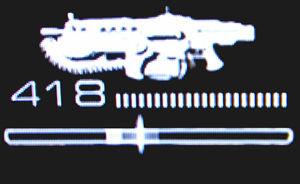 ACTIVE RELOAD: The designers of Gears of War looked at reloading and did something different. Instead of hitting a button and waiting for the animation to complete, players can try and hit the reload button again in a small window of opportunity. Doing so not only allows the player to start shooting again faster, but their ammo clip gets a temporary boost in power. If hit the reload button too early or too late, they suffer from an especially long reload time. This added layer of risk reward makes the reload mechanic more engaging than ever before.
ACTIVE RELOAD: The designers of Gears of War looked at reloading and did something different. Instead of hitting a button and waiting for the animation to complete, players can try and hit the reload button again in a small window of opportunity. Doing so not only allows the player to start shooting again faster, but their ammo clip gets a temporary boost in power. If hit the reload button too early or too late, they suffer from an especially long reload time. This added layer of risk reward makes the reload mechanic more engaging than ever before.
- TOUCH SCREEN CONTROLS: Games like Elite Beat Agesnts, Ossu! Tatakae! Ouendan, and The Legend of Zelda: Phantom Hourglass have vastly improved upon the controls of their predecessors. The touch controls are not only more intuitive, but more direct, dynamic, and engaging. Now players can tap, trace, spin, fight, throw, and move all with the pen point precision of handwriting. The touch screen has allowed so many DS games to support analog controls without an analog stick. This in itself is one of the touch screens best uses.
- SCANNING: In the Metroid Prime series, players can get additional information about various game elements by scanning them with the scan visor. After a second or two of scanning, the information is displayed on the screen. Some enemies and bosses take longer to scan than others, which can make obtaining the extra information quite risky. Scanning is essentially a CHECK mechanic that's more engaging because of how it engages with the first person perspective in 3D space. Unlike in most games, with the scan functionality players don't have to be right up next to the object they wish to investigate. Instead players have to be in range to scan an object and have a clear view of it. Seeing an object and then moving within range to investigate and focusing your view on an object to scan it are small yet effective touches that make what would otherwise be "hit x to inspect" more engaging.
 SHAKE MOTION CONTROLS: From deBlob to No More Heroes, many games have implemented a "shake the Wiimote vigorously" mechanic. Whether it unloads stored paint points or recharges your weapon, shaking the Wiimote around is certainly more engaging than button mashing.
SHAKE MOTION CONTROLS: From deBlob to No More Heroes, many games have implemented a "shake the Wiimote vigorously" mechanic. Whether it unloads stored paint points or recharges your weapon, shaking the Wiimote around is certainly more engaging than button mashing.
From ElectrOcean, Pikmin3D, Sonic Beyond, Pokemon O-SNAP, to the various repairs I've done on games, I'm always looking to innovate on the core mechanics/interaction of a game to make them more intuitive, direct, dynamic, analog, organic, and/or engaging.
I've always felt that adding features on top of a game never got the core of the issue.


Reader Comments (2)
The text entry system from Beyond Good and Evil should be required by law in all games with text input and an analog stick. It is genius.
@ Gregory Weir
I've purposely entered the wrong text just so I could keep using the system. Perhaps Ubisoft could make a typing of the dead with their spiral text engine?